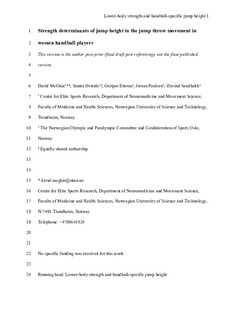| dc.description.abstract | McGhie, D, Østerås, S, Ettema, G, Paulsen, G, and Sandbakk, Ø. Strength determinants of jump height in the jump throw movement in women handball players. J Strength Cond Res XX(X): 000–000, 2018—The purpose of the study was to improve the understanding of the strength demands of a handball-specific jump through examining the associations between jump height in a jump throw jump (JTJ) and measures of lower-body maximum strength and impulse in handball players. For comparison, whether the associations between jump height and strength differed between the JTJ and the customarily used countermovement jump (CMJ) was also examined. Twenty women handball players from a Norwegian top division club participated in the study. Jump height was measured in the JTJ and in unilateral and bilateral CMJ. Lower-body strength (maximum isometric force, one-repetition maximum [1RM], impulse at ∼60% and ∼35% 1RM) was measured in seated leg press. The associations between jump height and strength were assessed with correlation analyses and t-tests of dependent r's were performed to determine if correlations differed between jump tests. Only impulse at ∼35% 1RM correlated significantly with JTJ height (p < 0.05), whereas all strength measures correlated significantly with CMJ heights (p < 0.001). The associations between jump height and strength were significantly weaker in the JTJ than in both CMJ tests for all strength measures (p = 0.001–0.044) except one. Maximum strength and impulse at ∼60% 1RM did not seem to sufficiently capture the capabilities associated with JTJ height, highlighting the importance of employing tests targeting performance-relevant neuromuscular characteristics when assessing jump-related strength in handball players. Further, CMJ height seemed to represent a wider range of strength capabilities and care should be taken when using it as a proxy for handball-specific movements. | nb_NO |
